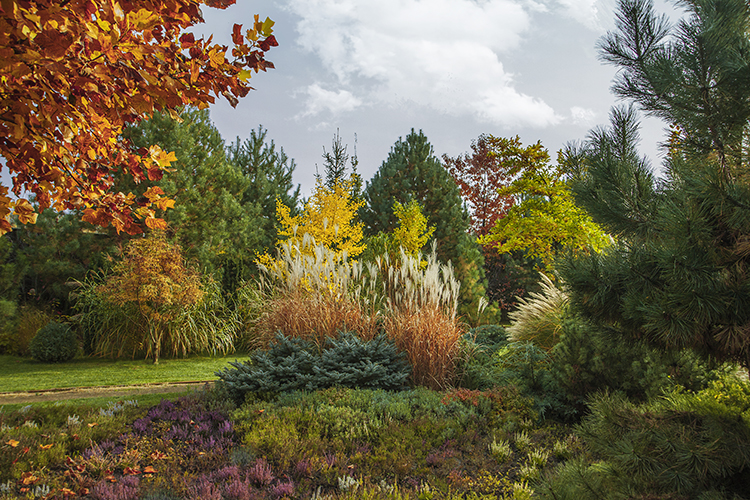
by A Touch of Dutch Landscaping | Sep 28, 2019 | Flowers, Foliage, Gardening, Landscape Design, Shrubs, Trees
Most of us would be hard pressed to find a person who doesn’t love the colours of fall. Yes, winter will inevitably follow fall, and probably earlier than we’d like. But, in the meantime, we’ve still got warm daytime temperatures, cool evenings, and so much colour to enjoy.
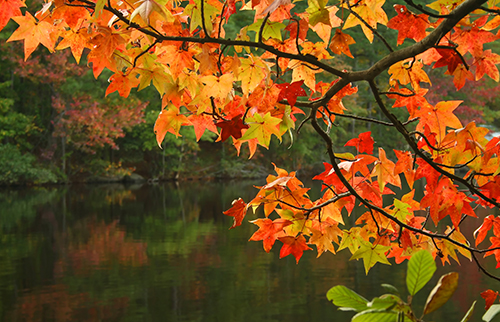 While the trees, plants, and shrubs throughout Southwestern Ontario offer up a lot of colour, many homeowners want colour in their own yards, as well. There are some quick fixes for this – displaying pumpkins, potted mums, and faux leaves and floral décor, for example. However, adding perennial colour to your fall garden takes a bit more forethought.
While the trees, plants, and shrubs throughout Southwestern Ontario offer up a lot of colour, many homeowners want colour in their own yards, as well. There are some quick fixes for this – displaying pumpkins, potted mums, and faux leaves and floral décor, for example. However, adding perennial colour to your fall garden takes a bit more forethought.
When planning gardens, home gardeners generally work in chronological order, considering what’s going to bloom or otherwise be at its peak in spring and then what will be at its best in summer. For this reason, autumn may tend to take a backseat where plant selection is concerned. To prolong the enjoyment of your gardens though, you may want to make room for a few fall favourites in your yard.
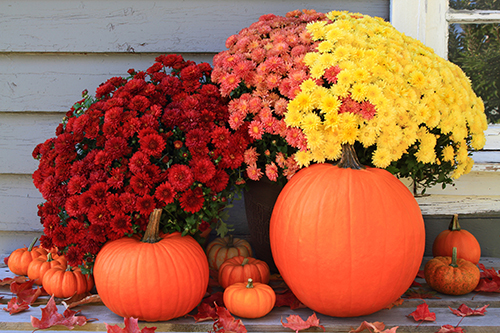 Plant retailers and nurseries might be among your best resources for determining what’s at its colourful peak right now. They tend to sell what’s in season, when it’s in season. And the warm, sunny days, cool nights, and more regular precipitation of early fall can be the perfect time to plant, offering ideal conditions for new plants, trees, and shrubs to take root before the first frost.
Plant retailers and nurseries might be among your best resources for determining what’s at its colourful peak right now. They tend to sell what’s in season, when it’s in season. And the warm, sunny days, cool nights, and more regular precipitation of early fall can be the perfect time to plant, offering ideal conditions for new plants, trees, and shrubs to take root before the first frost.
A few selections that fare well in our region in the fall include:
- Burning Bush (Euonymus alatas) – normally green deciduous foliage turns vibrant red
- Wayfaring Tree (Vibunum Lantana)
- Sugar Maple (Acer Saccharum) – foliage turns orange and red
- Mountain Ash (Sorbus) – foliage turns orange, red, and yellow
- Witch Hazel (Hamamelis) – foliage turns bright yellow
- Butterfly Bush (Buddleia) – flowers in fall, showing purple, blue, pink, and white
- Chrysanthemum (C. x morifolium) – fall flowers in yellow, orange, purple, red, burgundy, white, and bronze
- Purple Coneflower (Echinacea Purpurea) – large purple flowers and prominent seed heads
- Coralbells (Heuchera) – flowers throughout the season, leaves can show purple/bronze
- Rosemallow (Hibiscus Moscheutos) – large, saucer-like blooms are pink, blue, or purple
- Sedum Autumn Joy (Sedum spectabile) – flower clusters are generally pink or light purple
- Goldenrod (Solidago spp.) – bright yellow, flower clusters
Keep in mind though, that your plants and trees need a bit of TLC in order to get established before the first frost. Otherwise your investment of time and money may be for naught. If you’re not getting ample rainfall, you should water new plants thoroughly and consistently to help roots get established before the ground freezes. And ensure you get everything into the ground before the snow flies, as plants will have a much better chance of surviving the winter there than in the thin, plastic pots in which they’re generally sold.
 Once plants are in the ground, most of the initial growth is going to take place below the soil, which is good. So, don’t be disappointed if you see much going on above ground. Your patience will be rewarded with healthy, showy plants next year. To help things along and protect vulnerable young root systems, add a thick layer (4 inches) of mulch around plants. Mulch will add much needed insulation to keep heat in and cold out.
Once plants are in the ground, most of the initial growth is going to take place below the soil, which is good. So, don’t be disappointed if you see much going on above ground. Your patience will be rewarded with healthy, showy plants next year. To help things along and protect vulnerable young root systems, add a thick layer (4 inches) of mulch around plants. Mulch will add much needed insulation to keep heat in and cold out.
Although fall is a great time for planting, there are some exceptions. Evergreens need more time to adjust and build up stores of moisture. If not, they may dry out over the winter when the ground is hard and water supply is cut off. Also, some plants and shrubs sustain a bit of damage throughout the winter. A newly planted specimen may not be sufficiently established to handle the first winter, and may not make it through.
And finally, if you’re wanting to press your luck by planting something that is not ideally suited to your hardiness zone (Southwestern Ontario ranges anywhere from Zone 5 to 7), it will have a much better chance of surviving our winters if planted in spring and given a full growing season to acclimate.
Although many homeowners will start putting their gardens to bed for the year, plants are still growing and thriving in the early to mid-fall conditions. Take advantage of this time to change up your gardens, adding splashes of fall colour not just for this year, but for years to come.
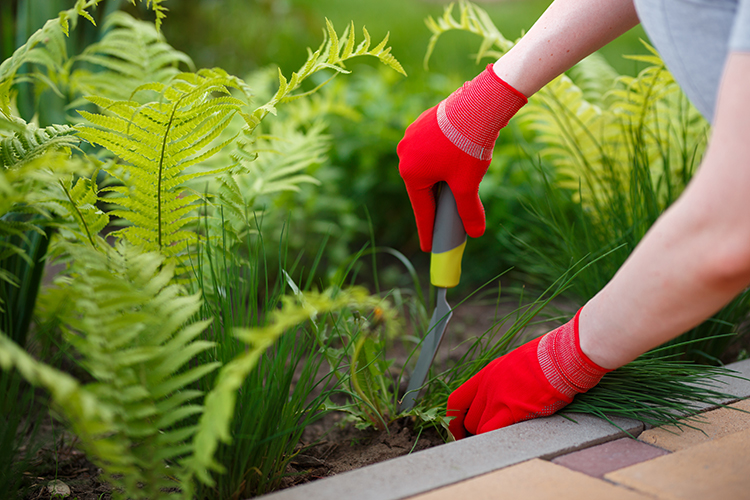
by A Touch of Dutch Landscaping | Aug 29, 2019 | Flowers, Foliage, Landscape Design, Maintenance, Softscaping
Where weeds come from
There are several classifications and definitions of weeds. However, in the very simplest terms, a weed is an unwanted plant in your lawn or garden.
No plant that’s perceived as a weed today has always been a weed. Once upon a time, they lived in a benign location and had no notable negative impact on their surroundings.
The turning point – when a plant becomes a weed – is when it invades a space where it is not desired and/or has an undesirable impact on people, animals, or other vegetation.
So, if they weren’t there to start with, how did those weeds get into your yard? They were carried there – transported by vehicle, animal, or on the wind.
And many seeds don’t need a whole lot of TLC to germinate. As long as they have oxygen and water, and a bit of sunlight, they will grow. So, the big question:
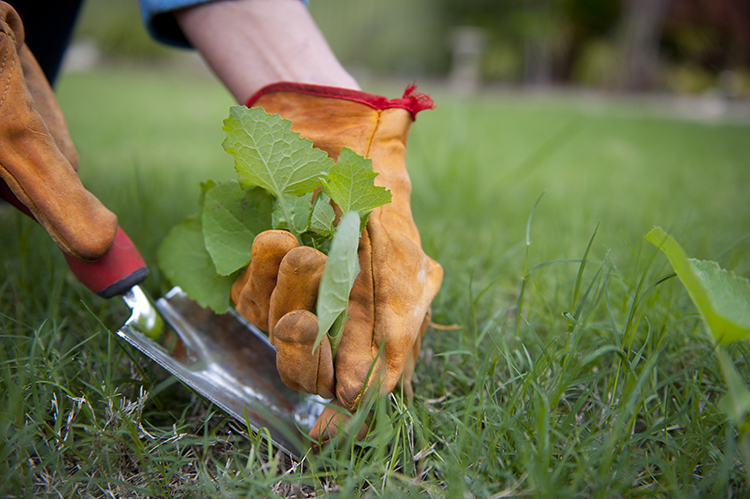
How to control weeds
Let’s face it – weed avoidance is not a thing. However, there are strategies that will help you tame the beast and minimize the negative impact of weeds.
- Cut off their food supply
As mentioned above, weeds need water, oxygen, and sunlight. So water only desired plants and plant closely together. Weeds don’t tend to grow as prolifically under other plants. The less exposed area you have in your gardens, the fewer weeds you will have to pull.
- Don’t disturb the soil.
When adding new plants or removing weeds from your lawn and garden, closely target the soil or weed in question. Weed seeds are generally present throughout your soil, so turning the soil brings new seeds closer to the surface, giving them the opportunity to germinate.
- Mulch is your friend.
Keep exposed soil covered with a thick (about 4 inches) layer of good quality mulch. This deprives weed seeds of sunlight, helping to keep them at bay. Some prefer crushed stone or river rock. These work as well. Just be sure to add a base layer of landscaping fabric over the surface before adding the rock. Keep in mind though that new seeds that are deposited from animals or the wind will germinate, so see the next tip.
- Weed early and often.
The sooner you pluck weeds out, the easier removal will be and the less damage they will do. If you give weeds a chance to take root, they’ll develop stronger, deeper roots systems at one end and seed heads (which will distribute more seeds) at the other. The best time to weed is after a good rain, when the ground is soft and roots will release more easily.
Weeds in your lawn and garden are the bane of any homeowner’s existence. But, armed with the information above, you’ll have a better understanding of where they’re coming from and how to control them.
Ready, set, weed!
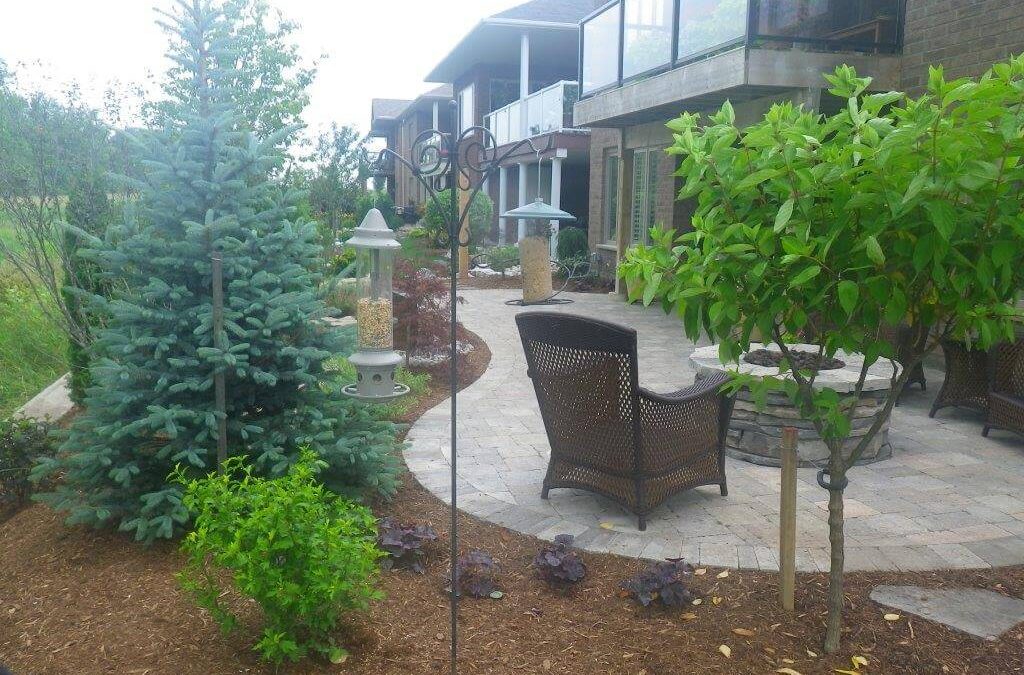
by A Touch of Dutch Landscaping | Jul 18, 2019 | Hardscaping, Landscape Design, Lawn care, Maintenance, Native Plants, Walkways
What to expect with low-maintenance landscaping
When we’re consulting with clients about their goals for new landscaping projects, by far the most requested characteristic is “low-maintenance”. But keep in mind that “low-maintenance” doesn’t mean “no maintenance”, so there’s still some work involved in keeping your lawn and garden looking great all season long.
If you’re looking to minimize the amount of work your lawn and flowerbeds need, we’ve got some tips that will allow you to spend more time enjoying your outdoor living spaces and less time maintaining them.
The Low-Maintenance Lawn
It may surprise you to learn that your lawn generally requires a lot more time to maintain that gardens do. Weeding, feeding, seeding, sodding, cutting, trimming, and watering all repeatedly require time, effort, and resources.
As such, the first thing we recommend doing is considering how much lawn you need for your lifestyle. While grass-covered turf does offer certain environmental benefits like absorbing toxins and carbon dioxide, other landscaping options can be just as beneficial. Chances are you can drastically reduce the amount of grass in your yard and replace those areas with other, much lower-maintenance elements.
One sure-fire way to reduce high-maintenance grass is to add some hardscaping to your yard. In addition to your driveway, porch, and deck, you might consider expanding your living space with a stone patio, fire pit area, and/or walkways. Adding crushed stone and pavers to high-traffic areas can significantly reduce maintenance while improving draining and weed control.
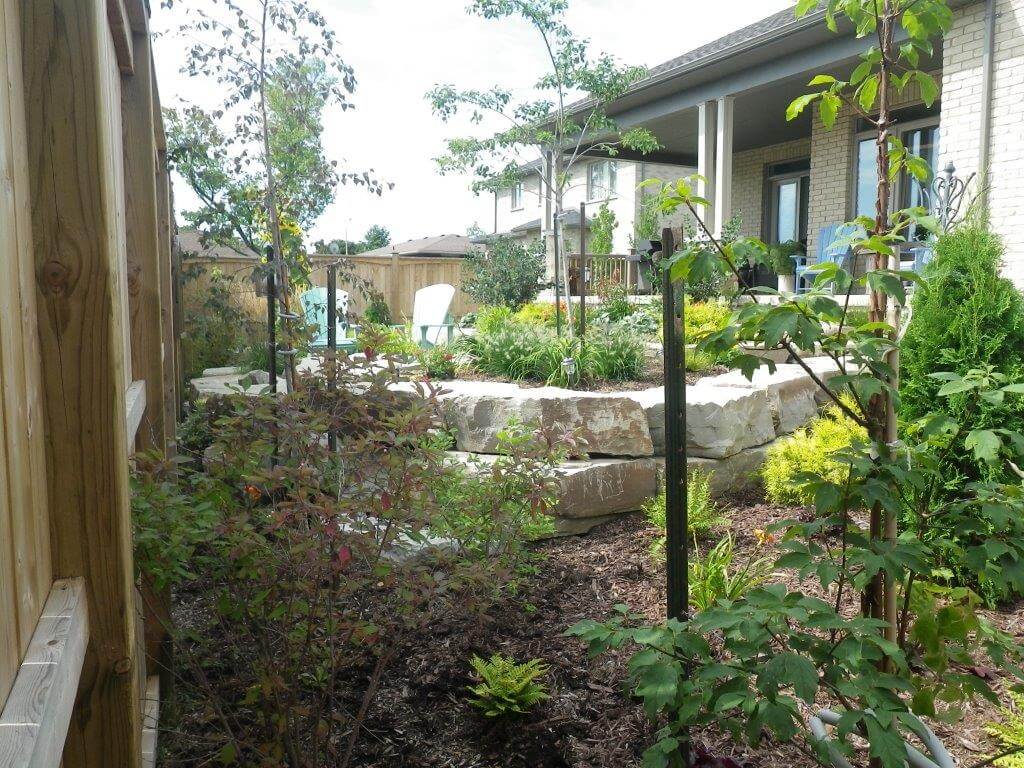
Trees
Large trees may require some maintenance in the form of trimming and/or raking leaves, but they offer many aesthetic and environmental benefits.
If you plan to add trees, give them a wide skirt of exposed earth (out to the drip line) and mulch well. This not only looks good, but furthers the reduction of grass that would otherwise need to be maintained.
Plant Selection
We’re fortunate to have myriad options when it comes to plants, flowers, and shrubs. However, if your goal is low-maintenance landscaping, you’ll want to be selective.
First and foremost, you can ensure the lowest maintenance gardens by choosing plants that are native to your region. These plants thrive in your region’s climate and soils, and historically have grown in the wild with no one but Mother Nature maintaining them. So you can bet they’ll thrive in your garden without too much attention.
Favour perennials over annuals. While the latter tend to be showier, they require more maintenance (deadheading and watering) and need to be replaced every year, adding both time and expense to your gardening requirements. To add pops of colour to your porch and patio but keep maintenance manageable, plant annuals in large containers.
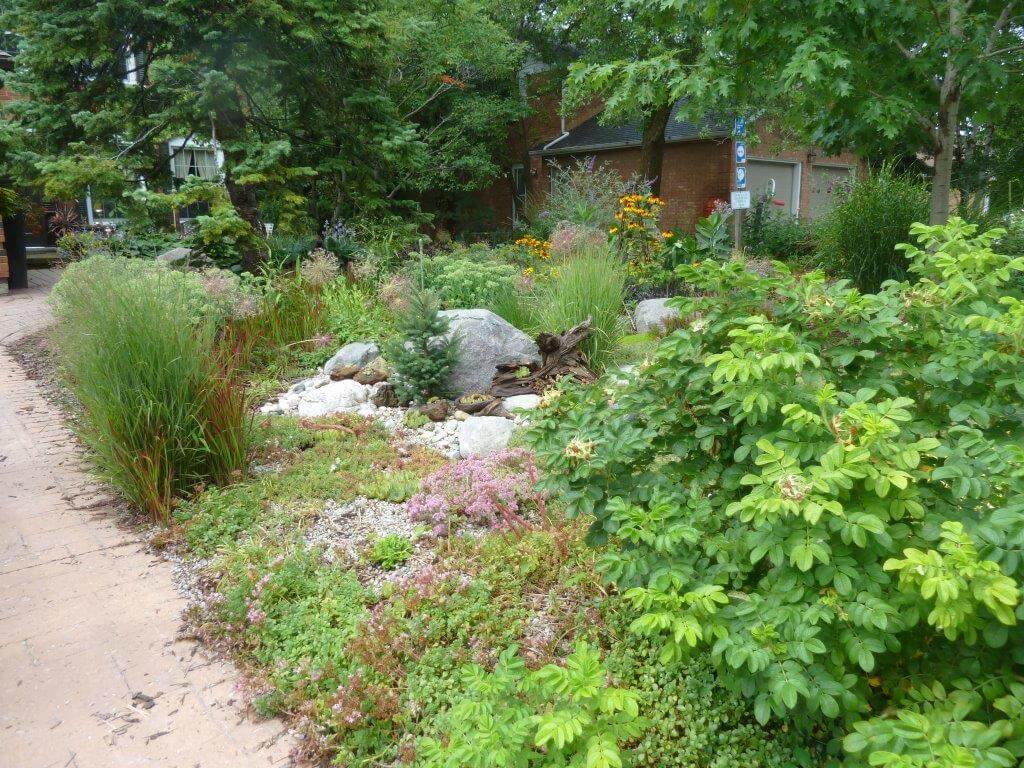
It’s important to consider sun exposure when selecting plants – both annuals and perennials – for gardens and planters. Shade-loving plants will become scorched in anything other than morning sunlight. Sun-lovers planted in the shade will not reach their full potential and will get “leggy” reaching for the sun.
While it’s visually appealing to choose a variety of shapes, sizes, and textures, be sure to select plants for your garden that have similar needs. This will help you avoid having to care for plants individually, permitting you instead to apply what maintenance is required to all plants in your garden.
Beautiful plants come from healthy soil. Soils that are rich in nutrients with good drainage and low competition from weeds will foster healthy plants without much assistance.
Good quality compost adds a wide range of nutrients and healthy bacteria to soil, and can also ensure appropriate drainage. Peat moss can also improve drainage but has an acidic pH. Raised beds also drain better than those dug down into the ground. Finally, a thick layer of mulch will help reduce watering requirements and minimize weed growth. Topped up every spring, mulch also feeds the soil and adds a polished look to flower beds and gardens.
Here in Southwestern Ontario, our outdoor living season is short, so maximize enjoyment by minimizing your work. Consider where you spend the bulk of your time and effort outside and determine ways to reduce or eliminate it so you can spend more time basking in our summer weather, while it lasts.
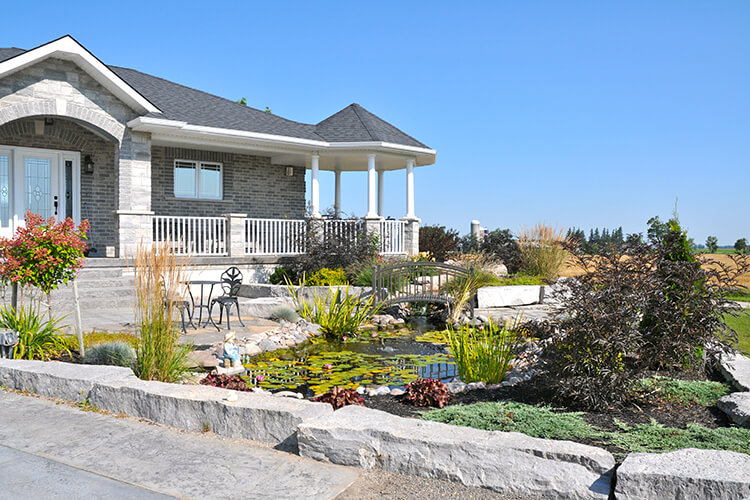
by A Touch of Dutch Landscaping | Jun 23, 2019 | Fencing, Hardscaping, Landscape Design, Ponds, Retaining Walls, Walkways, Water Features
Enhance the comfort and beauty of your yard with hardscaping
Hardscaping is probably not a term you use very often, but it’s actually a common facet of landscaping. In fact, you probably have some hardscaping elements in your yard.
The “hard” in hardscaping refers to the non-living or inanimate elements in a yard’s layout. In contrast, “softscaping” includes all living matter including plants and flowers, trees and shrubs, plus soil, mulch, and of course grass.
Natural stone, wood, gravel, concrete (precast and pour-in-place), interlocking brick, and composite are the most common hard materials used in the creation of fencing, retaining walls, waterfalls, ponds, patios, pathways, and more.
Standard inclusions in virtually any property are walkways, a driveway, decking, and fencing. However, many home owners opt to upgrade at some point, either to add new features to their existing landscape or simply to update outdated elements.
So how do you decide what features to add or change and which materials to use? When we consult with our clients, we consider several variables including specific goals, personal style, the style of the home and surroundings, and budget.
One of the primary goals that hardscaping can help address is added privacy. You can achieve this by adding a fence line or panels, a wall(s) or even just creating a privacy screen on one or both sides of your deck or patio. To soften the overall appearance, consider combining hardscaping elements with tall shrubs or ornamental grasses that can also enhance privacy.
Another common goal is expanding outdoor living space. Options here are dependent on available space and budget, and can range from a small deck to a multi-tiered patio with an entertainment area, bar, built-in kitchen, pool, pond, waterfall, and/or fire table with seating.
Natural stone retaining walls are a great solution for adding depth and visual interest, or dealing with a steeply graded yard or uneven grading around the perimeter. Armour stone is a popular choice for creating retaining walls as they are large, but natural and create visual impact.
Pathways to and around your home can add visual appeal and can also create visual separation and definition of gardens. Although poured concrete is the standard for walkways between the driveway and front entrance, explore other options like flagstone, interlocking brick, decorative pavers, or even materials generally relegated to the backyard like wood or composite.
If there are areas around your home where grass doesn’t thrive due to inadequate drainage or poor sun exposure, adding gravel and stepping stones can improve the appearance while also making navigation around those areas easier.
A couple caveats before you get started
- Even if you plan to add hardscaping in phases – say, the patio first, and then a pond and retaining walls over the next couple years – it’s best to create the whole plan at the outset so that you can be sure everything will work together when the entire project is completed. Short-term oversights can lead to long-term headaches.
- Think about drainage and environmental issues when adding immovable objects like a patio or a wall. Consider incorporating a means of collecting runoff water for use around your yard.
- Balance is best. You can create contrast with various sizes and shapes. Use two to three different complementary materials in your project. And most importantly, don’t overdo it with hard elements in your yard. Mix hardscaping with softscaping for best results.
- Ensure your design is appropriate for your lifestyle. If you have young children, maintaining an open, grassy area is probably a good idea. If you’re older and want a low-maintenance yard, you might opt for more hardscaping and drought-tolerant plants.
- Choose the right materials for your style. Whether your taste is modern, traditional, or somewhere in between, some materials are going to suit your style better than others, so choose carefully.
Hardscaping can add so much beauty to your yard and enjoyment to your outdoor living space. Just be sure to plan ahead for best results. Of course, sometimes it’s all just too daunting. A Touch of Dutch Landscaping and Garden Services can consult with you to create and implement a plan and design that meets your needs and fits your budget. Contact us to get started.

by A Touch of Dutch Landscaping | Jun 4, 2019 | Flowers, Landscape Design, Native Plants, Shrubs, Trees
Native plants are those that have thrived in their original region for centuries. Just like native animals, they have evolved over the years to adapt to changes in their environment.
In the last half of the twentieth century, the ever-burgeoning global marketplace opened people’s eyes to foreign and exotic varieties. Increasingly, hybrids of non-native species were created to adapt these plants to different climates.
However, in the last 15 – 20 years native species are making a comeback for several reasons.
It’s not an all-or-nothing proposition
Native varieties can generally be planted with non-native plants, assuming their sun, water, and soil requirements are similar. And the wide range of native species available means you can always find one or more that suits your gardens’ style, whether traditional, contemporary, or somewhere in between.
Enjoy your garden without having to tend to it all the time
Native plants tend are generally well adapted to their environment. So as long as you’re planting them in their preferred surroundings in terms of exposure to sun, precipitation, and soil type they should require little if any maintenance, especially once established.
Invite beneficial wildlife into your yard
One of the major reasons that native gardening is regaining popularity is its ability to attract pollinators like birds, bees, and butterflies. Native vegetation offers nutritionally-appropriate food as well as shelter to some of your region’s wildlife.
They don’t call them hardiness zones for nothing
Because your region’s original plants have evolved in your climate, they have developed certain immunities that make them more resilient in the face of pests and disease.
They’re just as beautiful and varied as their imported counterparts
While many perceive some native plants and wildflowers to be weedy and undesirable, there’s an extensive range of plants, trees, and bushes that have showy, colourful flowers and foliage, bright berries, and subtle fragrance.
If you’re interested in adding more native content to your garden, the following are some of the more popular native species, divided into five categories.
Trees
 While our country is known for the maple leaf, there are actually more than 150 varieties of maple throughout the world and only a handful of them are indigenous to Canada. But we’ve got more than just maples trees in our backyard. The range of native coniferous and deciduous trees in our region is quite diverse, each with its own unique traits.
While our country is known for the maple leaf, there are actually more than 150 varieties of maple throughout the world and only a handful of them are indigenous to Canada. But we’ve got more than just maples trees in our backyard. The range of native coniferous and deciduous trees in our region is quite diverse, each with its own unique traits.
Among our native deciduous tree species are the Ironwood, Cottonwood, and Oak, while coniferous native trees include White Cedar, Red Pine, and both Black and White Spruce.
Shrubs
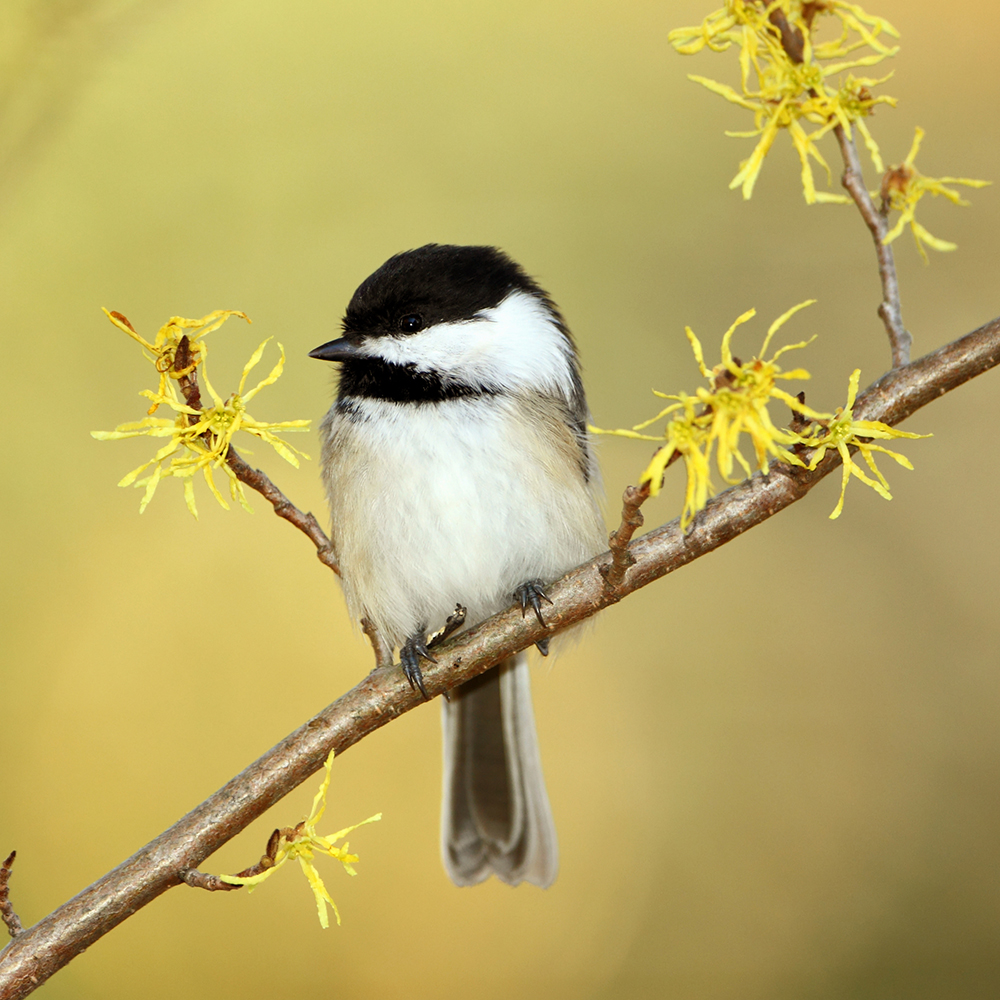 Our region offers some beautiful native shrubs that will add colour and texture to any landscape. Foliage ranges from bright green and smokey-blue, to purple and brilliant red, depending on the season. Many shrubs have a flower phase as well, temporarily enhancing its natural beauty and fragrance.
Our region offers some beautiful native shrubs that will add colour and texture to any landscape. Foliage ranges from bright green and smokey-blue, to purple and brilliant red, depending on the season. Many shrubs have a flower phase as well, temporarily enhancing its natural beauty and fragrance.
Varieties include the Honeysuckle Bush, whose flowers attract hummingbirds, bees, and butterflies. The Serviceberry is a popular native choice, covered in small white flowers in the spring and changing to brilliantly-coloured foliage in the fall. Witch Hazel shows green foliage throughout the summer and, after leaves begin to drop in the fall, shows off unique, bright yellow flowers.
Perennials
 Ontario’s hardy perennials are not only resilient but showy as well. Some are low-lying ground cover while others grow tall, which means it’s easy to create a stunning perennial garden consisting solely of native plants.
Ontario’s hardy perennials are not only resilient but showy as well. Some are low-lying ground cover while others grow tall, which means it’s easy to create a stunning perennial garden consisting solely of native plants.
Choose from brightly coloured Echinacea and Black-Eyed Susan, or pretty purple-pink Border Phlox. The fragrant Bee Balm’s flowers attract pollinators in the summer while its seed heads are a food source for birds in the winter. The Blanket Flower (in the Aster family) has sunshiney red and yellow flower heads, and Columbine can add a modern look to your garden with its long-stemmed nodding flowers.
We’d be remiss if we didn’t mention Ontario’s floral emblem, the Trillium. The beauty of this groundcover is in the simplicity of the flower. And contrary to popular belief, it is not illegal to pick a Trillium, but it’s not advisable as plants are easily damaged and difficult to successfully transplant.
Edible Fruit
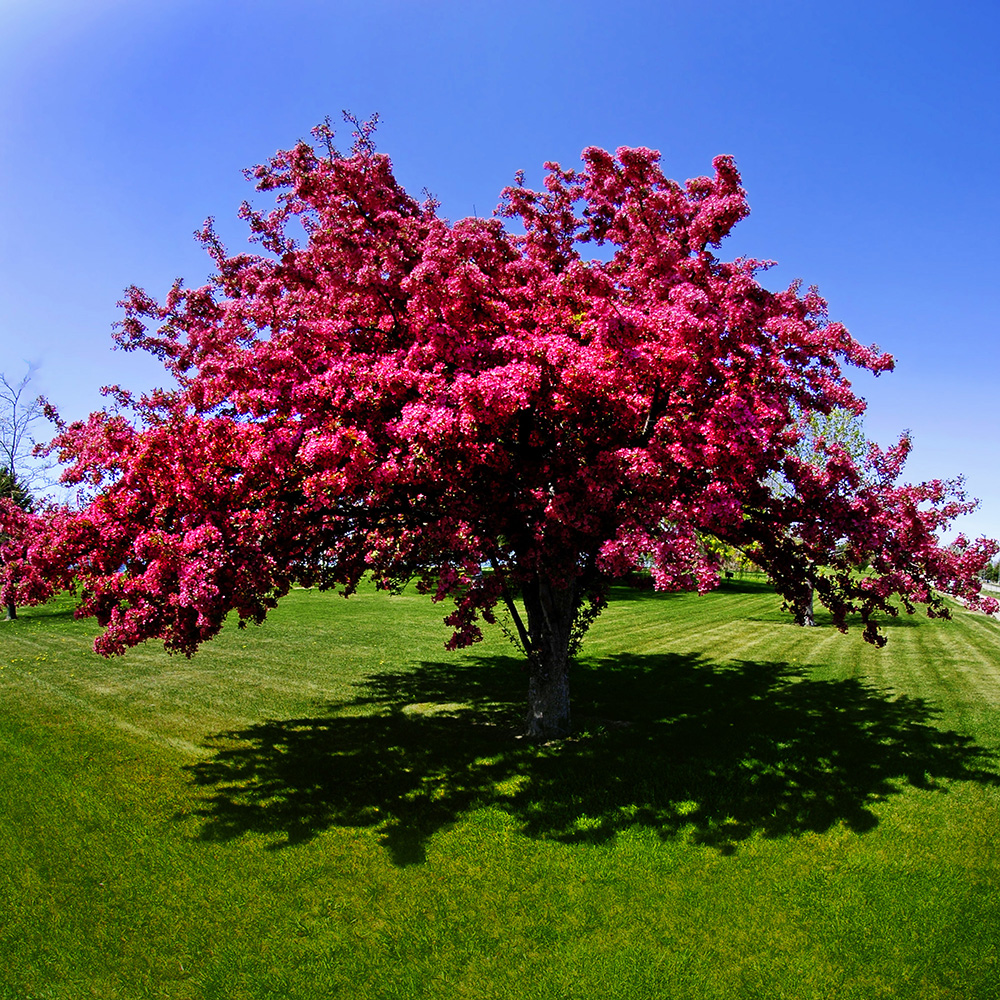 There are so many options when it comes to choosing edible fruit-bearing plants and trees native to Ontario. Various hard fruit trees like apple and crabapple varieties thrive here because they’re native to the region. Elderberry and raspberry (black, flowering purple, wild red) bushes are also native to our region and yield delicious fruit than can be eaten out of hand or baked into a multitude of desserts. The fruit of the Sumac is interesting as the berries are used as a seasoning.
There are so many options when it comes to choosing edible fruit-bearing plants and trees native to Ontario. Various hard fruit trees like apple and crabapple varieties thrive here because they’re native to the region. Elderberry and raspberry (black, flowering purple, wild red) bushes are also native to our region and yield delicious fruit than can be eaten out of hand or baked into a multitude of desserts. The fruit of the Sumac is interesting as the berries are used as a seasoning.
Ferns & Grasses
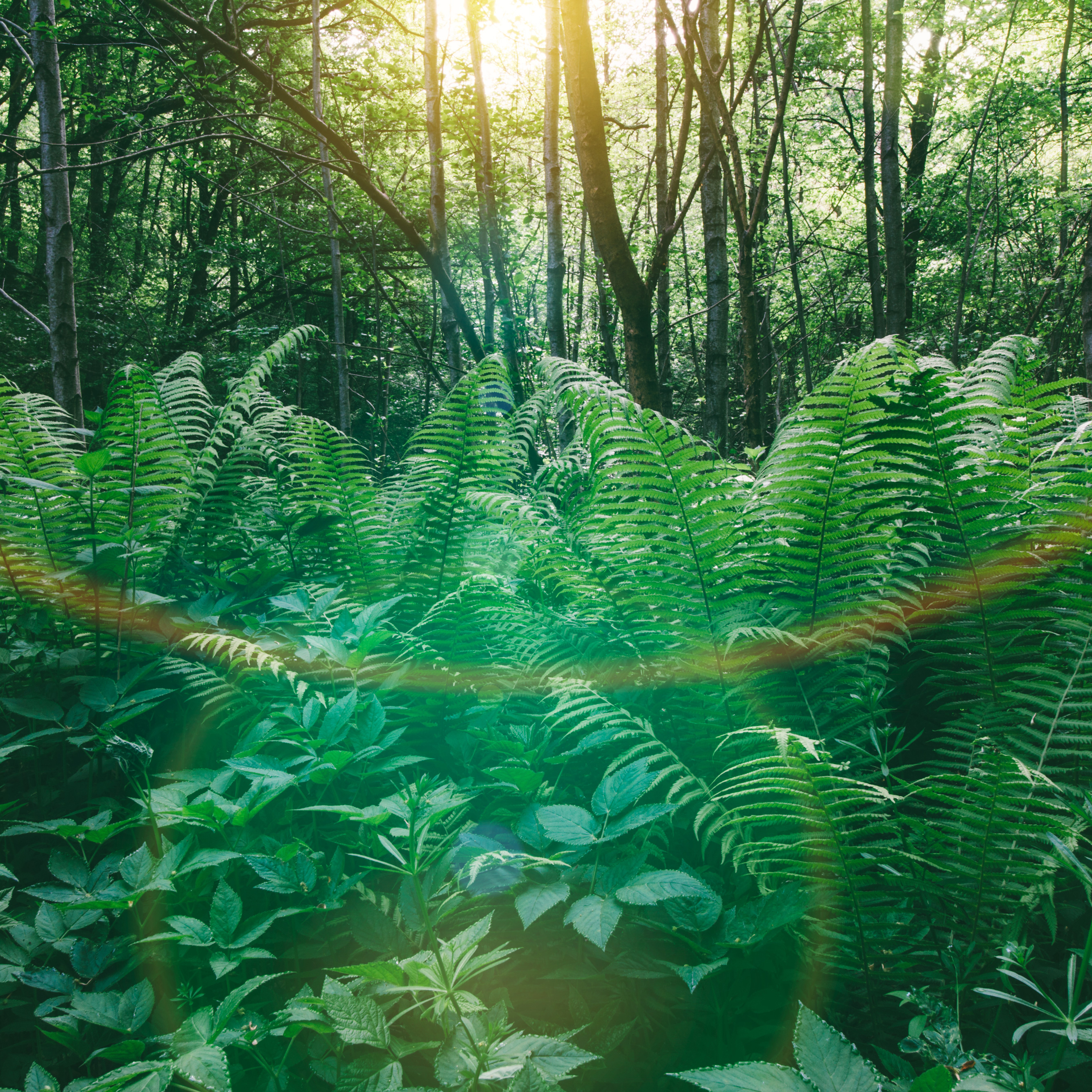 Suffice it to say that if you’re looking for native ferns and/or grasses in our region, your options are wide open. The Ostrich Fern is one of the most popular native ferns but it’s really just the tip of the iceberg. Regardless of which fern you choose, just ensure it’s planted in part to full shade with consistently moist soil. If you prefer grasses, there are myriad native varieties, both long and short. Many flower in the late summer/early fall and provide great visual interest in the winter as well.
Suffice it to say that if you’re looking for native ferns and/or grasses in our region, your options are wide open. The Ostrich Fern is one of the most popular native ferns but it’s really just the tip of the iceberg. Regardless of which fern you choose, just ensure it’s planted in part to full shade with consistently moist soil. If you prefer grasses, there are myriad native varieties, both long and short. Many flower in the late summer/early fall and provide great visual interest in the winter as well.
Gardening with native plants is not difficult. Not only are the plants, shrubs and trees easy to find at nurseries throughout the region, they’re even easier to incorporate into any landscape. If you’re interested in achieving a more beautiful native garden that attracts pollinators but you don’t want to do it yourself, contact A Touch of Dutch Landscaping & Garden Services.

by A Touch of Dutch Landscaping | Feb 20, 2019 | Hardscaping, Landscape Design, Maintenance, Softscaping
When it comes to landscaping planning and design, many people know what they like when they see it, but just don’t know how to transform their garden from its current state to what they envision. There’s a lot to consider – your preferred style, available space, soil type, irrigation, sun exposure, and maintenance expectations.
Gardens take time, energy, and money to establish and maintain, but starting with a plan can help minimize ongoing cost and effort. When customers call A Touch of Dutch Landscaping & Garden Services we create a plan that incorporates all of the aforementioned considerations. But if you’d like to create a plan of your own, here are some tips for creating something that will work for you and your outdoor space.
Landscaping Planning and Design – Understand Your Space
While we recommend you have at least a general idea of the space you’re working with, many find it helpful to draw or map out the space to get an idea of square footage, nearby elements, sun exposure, and more.
If you are making over an existing garden, consider what has and hasn’t worked in the past. Regardless of whether you’re updating or starting from scratch, think about the location of the garden. Is it against a fence or wall, around a porch, deck, or patio, or will it be exposed on all sides? You’ll want to select plants in a range of sizes to add dimension, and whose height and width will be appropriate for the size of the garden without contributing to a too-sparse or overcrowded appearance.
Understand Your Style
One of the worst times to decide on your style is probably when you’re at a garden centre or nursery. Everything on display is typically in season at that time and so their showy foliage and/or blooms are competing for your attention. Instead, make note of designs that you’re drawn to.
Whether you’re using magazines, Pinterest, or Houzz, or even out and about in your own neighbourhood. Take pictures or jot down notes about general styles and specific elements that you like. This practice really helps inform your plan, so that when you go shopping for plants, you don’t get swayed by some pretty shrub that’s not remotely close to what you’re after.
Understand Your Maintenance Threshold
Maybe you’re a green thumb. But, maybe you’re not. While some amount of maintenance is required for every garden, regardless of style or size, there are ways to minimize the amount of upkeep required to ensure a landscaping project continues to thrive, long term.
If you’re updating an existing flowerbed, consider which individual plants require the most maintenance and get rid of them. When planning for new garden elements, be aware of drought tolerance, sun exposure requirements, standard height and width projections, preferred soil types, and what else is or will be planted in the space. If you make poor plant choices, keeping them alive is going to require more effort than you might be willing to expend. Things like extra watering, fertilization, amending the soil, and trimming might be added to your to-do list on a regular basis.
When you’re putting your plants in the ground, consider adding a layer of mulch or stones. Not only do these extra layers help keep weeds at bay, but they also add a layer of insulation to the soil, keeping warmth in while slowing down evaporation. This means both less weeding and less watering!
Understand Your Limits
If you’re short on time, energy, inspiration, or knowledge, consider leaving the design and installation to a professional landscaper. This will this ensure your project gets done in a timely manner. What’s more, your wishes will be factored into the landscape design to ensure that the end result is beautiful and done right, and meets your design standards.
If you do want to enlist the services of a landscaping company, the sooner you contact the landscaper the better. While we don’t generally start installing softscaping, hardscaping, and water features until May, planning, design, and scheduling gets underway much earlier in the year. So, by the time planting season actually rolls around, we already have much of our season planned. And weather is a big factor, too. Cold weather that persists longer than usual into the spring or that starts earlier than usual in the fall affects our schedule, as does each day of inclement weather during the season.
There’s a saying that if you fail to plan, you plan to fail. That’s probably as true in landscaping as it is in anything else. Having a garden plan can save you time, effort, and money, before during and after you plant. So, investing some time and effort into formulating a plan will pay off. And if you aren’t up for doing your own landscaping planning and design, contact us to discuss how A Touch of Dutch Landscaping & Garden Services can help you design and install the garden you’ve been dreaming of.

 While the trees, plants, and shrubs throughout Southwestern Ontario offer up a lot of colour, many homeowners want colour in their own yards, as well. There are some quick fixes for this – displaying pumpkins, potted mums, and faux leaves and floral décor, for example. However, adding perennial colour to your fall garden takes a bit more forethought.
While the trees, plants, and shrubs throughout Southwestern Ontario offer up a lot of colour, many homeowners want colour in their own yards, as well. There are some quick fixes for this – displaying pumpkins, potted mums, and faux leaves and floral décor, for example. However, adding perennial colour to your fall garden takes a bit more forethought. Plant retailers and nurseries might be among your best resources for determining what’s at its colourful peak right now. They tend to sell what’s in season, when it’s in season. And the warm, sunny days, cool nights, and more regular precipitation of early fall can be the perfect time to plant, offering ideal conditions for new plants, trees, and shrubs to take root before the first frost.
Plant retailers and nurseries might be among your best resources for determining what’s at its colourful peak right now. They tend to sell what’s in season, when it’s in season. And the warm, sunny days, cool nights, and more regular precipitation of early fall can be the perfect time to plant, offering ideal conditions for new plants, trees, and shrubs to take root before the first frost. Once plants are in the ground, most of the initial growth is going to take place below the soil, which is good. So, don’t be disappointed if you see much going on above ground. Your patience will be rewarded with healthy, showy plants next year. To help things along and protect vulnerable young root systems, add a thick layer (4 inches) of mulch around plants. Mulch will add much needed insulation to keep heat in and cold out.
Once plants are in the ground, most of the initial growth is going to take place below the soil, which is good. So, don’t be disappointed if you see much going on above ground. Your patience will be rewarded with healthy, showy plants next year. To help things along and protect vulnerable young root systems, add a thick layer (4 inches) of mulch around plants. Mulch will add much needed insulation to keep heat in and cold out.







 While our country is known for the maple leaf, there are actually more than 150 varieties of maple throughout the world and only a handful of them are indigenous to Canada. But we’ve got more than just maples trees in our backyard. The range of native coniferous and deciduous trees in our region is quite diverse, each with its own unique traits.
While our country is known for the maple leaf, there are actually more than 150 varieties of maple throughout the world and only a handful of them are indigenous to Canada. But we’ve got more than just maples trees in our backyard. The range of native coniferous and deciduous trees in our region is quite diverse, each with its own unique traits. Our region offers some beautiful native shrubs that will add colour and texture to any landscape. Foliage ranges from bright green and smokey-blue, to purple and brilliant red, depending on the season. Many shrubs have a flower phase as well, temporarily enhancing its natural beauty and fragrance.
Our region offers some beautiful native shrubs that will add colour and texture to any landscape. Foliage ranges from bright green and smokey-blue, to purple and brilliant red, depending on the season. Many shrubs have a flower phase as well, temporarily enhancing its natural beauty and fragrance. Ontario’s hardy perennials are not only resilient but showy as well. Some are low-lying ground cover while others grow tall, which means it’s easy to create a stunning perennial garden consisting solely of native plants.
Ontario’s hardy perennials are not only resilient but showy as well. Some are low-lying ground cover while others grow tall, which means it’s easy to create a stunning perennial garden consisting solely of native plants. There are so many options when it comes to choosing edible fruit-bearing plants and trees native to Ontario. Various hard fruit trees like apple and crabapple varieties thrive here because they’re native to the region. Elderberry and raspberry (black, flowering purple, wild red) bushes are also native to our region and yield delicious fruit than can be eaten out of hand or baked into a multitude of desserts. The fruit of the Sumac is interesting as the berries are used as a seasoning.
There are so many options when it comes to choosing edible fruit-bearing plants and trees native to Ontario. Various hard fruit trees like apple and crabapple varieties thrive here because they’re native to the region. Elderberry and raspberry (black, flowering purple, wild red) bushes are also native to our region and yield delicious fruit than can be eaten out of hand or baked into a multitude of desserts. The fruit of the Sumac is interesting as the berries are used as a seasoning. Suffice it to say that if you’re looking for native ferns and/or grasses in our region, your options are wide open. The Ostrich Fern is one of the most popular native ferns but it’s really just the tip of the iceberg. Regardless of which fern you choose, just ensure it’s planted in part to full shade with consistently moist soil. If you prefer grasses, there are myriad native varieties, both long and short. Many flower in the late summer/early fall and provide great visual interest in the winter as well.
Suffice it to say that if you’re looking for native ferns and/or grasses in our region, your options are wide open. The Ostrich Fern is one of the most popular native ferns but it’s really just the tip of the iceberg. Regardless of which fern you choose, just ensure it’s planted in part to full shade with consistently moist soil. If you prefer grasses, there are myriad native varieties, both long and short. Many flower in the late summer/early fall and provide great visual interest in the winter as well.